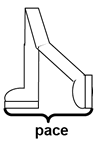Estimating length
Saturday, 03 May 2008 | 3 Comments
When looking at measurement, year 7 measure “body units” and use them to measure things in the classroom, as an example of estimating. Then, when we move onto perimeter, we come back to one body unit, the pace.
 We start in the classroom, measuring the length of our pace, recording the result on the worksheet.
We start in the classroom, measuring the length of our pace, recording the result on the worksheet.
Still in the classroom, we work out how many paces it will take to walk 3m, 10m and 15m. There’s a discussion generated, because the calculator gives an answer of 5.45454545. We wonder why this is, and what we should do about it (we round so we have a whole number of paces).
Then we go out to the volleyball court, it’s a nice manageable size. The students line up on one end, and they then walk the number of paces for 3m. The teacher, or a student, can then measure 3m with a trundle wheel and see how close our walking estimates were. At this point we discuss what we might try adjusting to get a better result (e.g. the pace walked outside might have been bigger or smaller than the one inside). We then pace out 10m and 15m, comparing to the actual measurement, hopefully the adjustments have got us more accurate.
There’s a variety of accuracy. Some students are near spot-on each time, most are a few paces out and a small number are way out (often because they’re taking giant steps outside and aren’t changing that even after a suggestion from me) – usually when the students are out, they’ve walked further than the actual measurement rather than less.
The second activity outside involves measuring the perimeter of the volleyball court. The students walk around the perimeter of the court, starting at a corner, counting the number of paces. We’ll take this number back to the classroom and use it to calculate the estimated length. (It’s a little funny watching the students follow each other around in a near perfect line intently concentrating on counting their steps)
The final activity is to get the students using the trundle wheels to measure the actual length of the court. With not enough trundle wheels for each student, I get them to work in twos or threes. One can push the trundle wheel, the other two count. They can go around a couple of times so everyone gets a turn of the trundle wheel, and to check their measurement. We can use the measurement to compare our estimate, it also opens up a discussion about the accuracy of measurement when the students all get different answers. You could also tie this to scale drawing, and get the students to draw a simple diagram of the volleyball court on the back of the worksheet where I’ve put some 1cm dot paper.
Posted in • Activity • Outside • Lesson Idea • Length • Perimeter • Printable • Worksheet | Short URL: http://mths.co/1171
Post a comment
Commenting is not available in this channel entry.New Subscribe to the …
MathsLinksemail newsletter
Get updates…
About
Simon Job — eleventh year of teaching maths in a public high school in Western Sydney, Australia.
MathsClass is about teaching and learning in a maths classroom. more→
Archive
Elsewhere
 @simonjob
@simonjob
updates via  @mathslinks
@mathslinks
Recently read/found.
Being a Vector is not Mutually Exclusive – Ringo Mok
maths vectorsInstagram
Gcf howie_hua maths
Comments